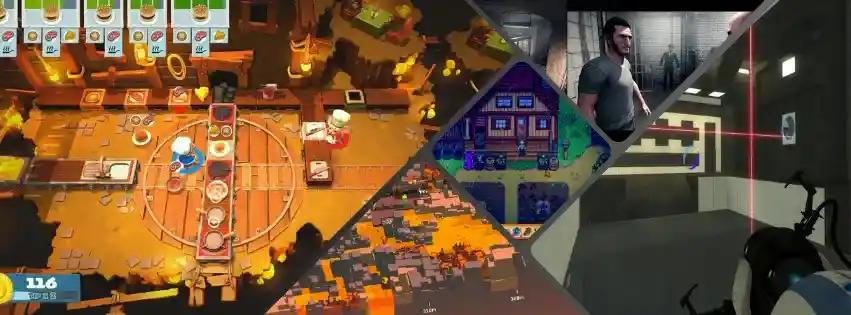Not every gaming PC needs a graphics card the size of a shoebox. Whether you're using an older laptop or a compact office machine, there’s a surprising number of fantastic games that perform well on modest hardware or the so called potato PC's — and are absolutely worth your time.
This collection focuses on titles that run on integrated GPUs like Intel UHD, Iris Xe, or AMD Vega, and don’t demand more than 8 GB of RAM or a dedicated graphics card. They’re easy to install, quick to launch, and perfect for shorter sessions — making them ideal for players who want to dive straight into the action without worrying about settings, heat, or frame drops.
This article is part of our guide: Best PC Games: Expert Recommendations for Every Gamer
Must-Play Games
These cross-list standouts appear in multiple guides and run great on older hardware. Tap any card to see where it features and find the best list to start.

Vampire Survivors
One-stick swarm-slayer spanning RPG, offline, and indie lists: tiny install, absurd build variety, buttery performance on integrated graphics, endless unlocks. Perfect five-minute loop for breaks.
Editor's Top Lists
Handpicked by our gaming experts
Can my PC run these?
So what exactly do we mean when we say low-end hardware? We have to come up with a baseline somehow. To run the games we chose smoothly, make sure your laptop or pc matches at least the minimum specs:
Component | Minimum Requirement | Recommended |
|---|---|---|
CPU | Intel Core i3 / AMD Ryzen 3 (8th gen or newer) | Intel Core i5 / Ryzen 5 |
RAM | 8GB | 16GB |
Storage | 256GB SSD | 512GB SSD |
Graphics | Integrated (Intel UHD / AMD Vega) | Iris Xe or better |
Display | 1080p resolution | 1080p IPS panel |
OS | Windows 10 or 11 | Windows 11 |
Performance Verified: All games in this hub are tested or community-verified to achieve stable 30+ FPS on the minimum specifications listed above.
Category Winners
Jump into any genre with the top three picks from each low-end PC list. Use these snapshots to compare options fast, then open the full guide for deeper lineups.
Shooting Games
Valorant
Tactical FPS with 128‑tick servers, precise gunplay, and hero utility. Scales to iGPUs, low input latency, robust anti-cheat. Built for reliable frames.
Team Fortress 2
Nine unique classes, limitless community servers, and objective modes keep matches fresh. Runs smoothly on decade-old hardware with scalable settings. Still hilarious chaos.
BattleBit Remastered
Massive 127v127 battles with proximity voice and widespread destruction. Low-poly art keeps frames high on integrated graphics while preserving large-scale tactics.
Multiplayer
Brawlhalla
Free-to-play platform brawler with cross-play, 50+ legends, responsive online via rollback networking. Runs effortlessly on low-power laptops. Quick queues, constant updates.
Valorant
5v5 competitive ladder with strict anti-cheat, precise recoil, and clutch-friendly economy. Optimized to sustain high FPS on integrated GPUs during intense firefights.
League of Legends
140+ champions, strategic 5v5 lanes, and ARAM for quick matches. Scales to low-end PCs with modest bandwidth needs and consistent 60fps settings.
Offline Games
Stardew Valley
Offline-friendly life sim with deep farming, relationships, mining, and crafting. Multi-year progression, mod support, low requirements. Perfect for unplugged weekends.
Vampire Survivors
No-connection autobattler where builds snowball into screen-filling chaos. Unlock characters, stages, Arcanas. Tiny download, runs flawlessly on dated CPUs while offline.
Undertale
Offline narrative standout: multiple endings, meta-aware saves, and memorable battles that emphasize choice. Minimal hardware demands mean virtually any laptop can experience it.
Strategy
Into the Breach
Chess-like grid battles using three-mech squads and environmental hazards to prevent damage. Short missions, immense replayability. Minimal requirements suit aging laptops beautifully.
Factorio
Factory-building obsession: automate from ore to rockets while optimizing belts and bots. Handles thousands of entities on integrated graphics. 60 UPS target keeps production humming.
FTL: Faster Than Light
Command crew, reroute power, vent fires, and board enemy ships in pausable skirmishes. Tiny footprint and low RAM usage suit nearly any office PC.
Story Driven
Undertale
Branching narrative where combat choices matter more than damage. Memorable characters, smart humor, stellar soundtrack. Minimal requirements; perfect for story-first, low-spec sessions.
STEINS;GATE
Definitive visual novel: branching time loops, meticulous pacing, and sharp localization. 30+ hours, runs on nearly any laptop. Headphones on; goosebumps guaranteed.
Pentiment
Hand-illuminated narrative adventure with period fonts, researchable leads, and meaningful time pressure. Low requirements make its multi-generational mystery accessible on modest machines.
Indie Classics
Stardew Valley
Indie standout built by one developer: deep farming loops, charming townsfolk, and extensive mods. Low system demands and stable 60fps on integrated graphics.
Papers, Please
Border checkpoint sim where discrepancies, bribes, and family expenses collide. 20+ endings, mouse-only controls, tiny install. Runs flawlessly on aging office PCs.
FTL: Faster Than Light
Indie classic marrying emergent storytelling with tight resource management. Unlock ships, mix augments, and brave sector events. Lightweight engine favors old laptops.
RPG's
Tales of Maj'Eyal
Feature-rich roguelike with tiles, flexible permadeath options, and sprawling class/race combinations. Extensive addons, low GPU dependency, and quick turns suit underpowered machines.
Vampire Survivors
Progression-heavy horde survival with permanent meta upgrades and weapon evolutions. Minimal inputs, big buildcraft payoffs. Runs flawlessly on integrated graphics and ancient CPUs.
Mount & Blade: Warband
Medieval sandbox with directional melee, mounted combat, and dynamic factions. Huge mod scene, scalable battle sizes, and forgiving requirements keep low-end rigs in the fight.
Horror
World of Horror
Retro 1‑bit terror inspired by Ito and Lovecraft: turn-based investigations, curses, and cosmic endings. Ultra-lightweight engine; ideal for ancient laptops at night.
Resident Evil 4 (2005)
Seminal over‑the‑shoulder horror with precise aiming, tense crowd control, and replayable Mercenaries. Runs at high frames on decade-old PCs with tuned settings.
Five Nights at Freddy's
Security-cam paranoia distilled: track animatronics, ration power, survive till 6 AM. Minimal storage and CPU demands make screams accessible on any machine.
Open World
Grand Theft Auto: San Andreas
Sprawling state with cities, countryside, and 100+ missions. Stable on ancient hardware, extensive modding, full controller support. Drive, fly, and conquer Grove Street.
Minecraft
Procedurally infinite sandbox with survival, creative, and Redstone engineering. Scalable render distance and settings maintain smooth performance on integrated graphics. Endless projects, zero ceiling.
Saints Row 2
Chaotic sandbox stuffed with diversions—insurance fraud, mayhem, and deep character customization. Full campaign co-op, modest requirements, and scalable settings keep old laptops laughing.
Survival
Don't Starve
Hand-drawn survival with seasons, sanity, and ruthless permadeath. Deep crafting and base-building, offline friendly. Low CPU/GPU demands make experimentation safe—until winter.
Cataclysm: Dark Days Ahead
Unforgiving open-source survival sim with tiles or ASCII, vehicle construction, and granular crafting. Negligible hardware needs; endlessly moddable. Terminal-friendly apocalypse.
This War of Mine
Civilian survival in a besieged city: manage hunger, illness, and guilt through day-night cycles. Modest requirements ensure somber storytelling reaches low-end machines.
All Game Lists
Browse by mode and genre
By Mode
By Genre
What we exclude and why
We exclude always-online live-service titles, games that need a dedicated GPU for 30+ FPS even at 720p, or installs exceeding 100GB unless exceptionally optimized. Games requiring constant internet connectivity or those with predatory monetization models are also omitted to ensure our recommendations respect both your hardware and wallet.
How we test
Our rigorous testing methodology
All games are tested on our baseline system (Intel Core i3-10100, 8GB DDR4 RAM, Intel UHD 630 graphics, 256GB SSD) or verified through community reports on similar hardware. We prioritize games achieving stable 30+ FPS at 1080p low-medium settings, though some entries may require 720p for optimal performance. Each spoke article includes detailed performance notes, recommended settings, and installation sizes. We audit this hub quarterly to remove deprecated titles and add newly verified games.
Frequently Asked Questions
Everything you need to know
What counts as a “low-end PC” in 2025?
We design our lists around budget laptops/desktops with Intel Core i3 / AMD Ryzen 3 class CPUs, 8GB RAM, an SSD, and integrated graphics (Intel UHD / AMD Vega / Iris Xe) running Windows 10/11. Our typical target is a stable 30+ FPS at 720p–1080p on Low/Very Low settings.
Can I play these games on Intel UHD 620 or AMD Vega 8 integrated graphics?
Yes—most recommendations are verified for common iGPUs like UHD 620/630, Iris Xe, and Vega 8/11. Expect 30–60 FPS at 720p–900p on Low with resolution scaling. Heavier titles may need additional tweaks (reduced shadows, foliage, and post-processing).
Do I need a dedicated GPU for the games in this hub?
No—our hub focuses on titles that do not require a dGPU. If a game benefits from one, we’ll call it out and downrank it. When in doubt, try 720p, cap FPS to 30 or 45, and enable any in-game scaler (FSR/Resolution Scale) for smoother results on iGPU.
Will 4GB of RAM work for “potato PC” gaming?
Some ultra-light classics and 2D/retro titles run on 4GB, but we recommend 8GB+ for modern OS/browser overhead. If you’re stuck on 4GB: close background apps, use 720p, set textures to Low, and prefer games with small installs and modest memory footprints.
What settings should I use on a low-end laptop to boost FPS?
Start with: 720p (or 80–90% resolution scale at 1080p), Low/Very Low presets, V-Sync off, shadows & ambient occlusion off, foliage/particles low, and a frame cap at 30 or 45 FPS. Prefer DX11/Vulkan backends and enable FSR/Resolution Scaling when available.
Can I play these low-end PC games offline, and which ones support co-op or multiplayer?
Many picks are offline-friendly (great for travel or limited internet). Others feature local/online co-op or multiplayer; we flag mode support in each spoke. If your connection is unstable, choose offline or local-co-op lists first. Check out our dedicated Offline, Co-Op and Multiplayer guides potato PC suitable games.
How can I improve performance without upgrading hardware?
Use an SSD, update GPU drivers (Intel/AMD), set a 30–45 FPS cap, switch to borderless windowed, lower render scale, and kill background apps (browsers/launchers). In many games, turning down shadows, reflections, and post-processing yields the biggest gains.
Are there good free or cheap games for low-end PCs?
Absolutely. Many lightweight indies and classics are free-to-play or under $5. We maintain separate spokes for free and budget picks; the hub links to those so you can filter by price without sacrificing performance.
Conclusion
Whether you're gaming between errands or just want something that runs reliably on your current setup, there’s no need to compromise on quality. Every recommendation here is handpicked to make the most of what you already have — without sacrificing what makes games fun.








